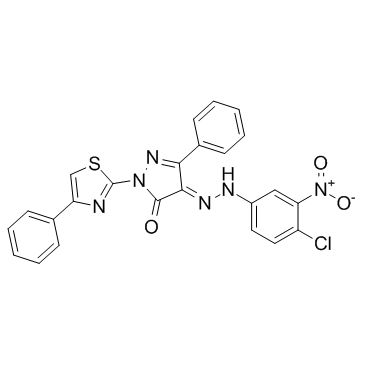| Description |
C87 is a novel small-molecule TNFα inhibitor; potently inhibits TNFα-induced cytotoxicity with an IC50 of 8.73 μM.
|
| Related Catalog |
|
| Target |
IC50: 8.73 μM (TNFα-induced cytotoxicity)[1]
|
| In Vitro |
C87 directly binds to TNFα, potently inhibits TNFα-induced cytotoxicity (IC50=8.73 μM) and effectively blocks TNFα-triggered signaling activities. C87 exhibits good solubility and consistent dose-dependent functions in vitro. C87 completely blocks TNFα-induced activation of caspase-3 and caspase-8. The activity of c-Jun N-terminal kinase (JNK) is significantly reduced by C87 in L929 cells. C87 also prevents the degradation of IκBα in cells treated with TNFα. C87 potently blocks multiple signaling transduction pathways and downstream target gene activation triggered by TNFα[1].
|
| In Vivo |
C87 attenuates TNFα-induced inflammation, thereby markedly reducing injuries to the liver and improving animal survival. C87 injection delays the incidence of death and increases the survival rate by two folds compared with the vehicle control. The level of alanine transaminase and aspartate transaminase is consistently reduced in mice with C87 treatment[1].
|
| Cell Assay |
The inhibition of the cytotoxic effect of human TNFα by compounds (C87) is measured in L929 cell line. L929 cells are seeded at a density of 104 cells/well in a 96-well plate and incubated for 24 h in RPMI 1640 with 10% FBS at 37 °C. Compounds (C87) are added to the cells with 1 μg/mL actinomycin D and 1 ng/mL TNFα and then incubated at 37 °C for 20 h before analysis. Cell survival is measured using the MTT method[1].
|
| Animal Admin |
BALB/c mice are used in the study. Before LPS/GalN challenge (LPS (50 μg/kg) and D-GalN (1.2g/kg)), mice are injected intraperitoneally with C87 (12.5 mg/kg), Enbrel (4 mg/kg), or vehicle, respectively, at 1, 8, and 16 h. Blood is collected with retro-orbital sampling. Activities of alanine transaminase and aspartate transaminase are detected. Liver tissues are collected and fixed in 10% formalin, and sections are stained with hematoxylin and eosin[1].
|
| References |
[1]. Ma L, et al. A novel small-molecule tumor necrosis factor α inhibitor attenuates inflammation in a hepatitis mouse model. J Biol Chem. 2014 May 2;289(18):12457-66.
|
